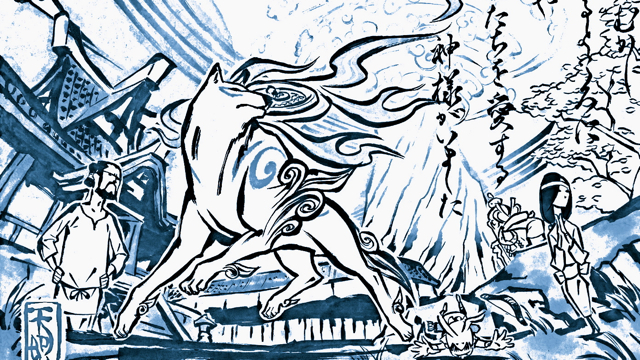
Here we are again. When I began writing the first part of this article, it wasn’t long before I realised that Ōkami was utterly jam-packed with layer upon layer of myths and legends spanning the entire length of Japanese history– certainly far too many to cover in only one editorial. Thankfully, my kind and generous editors have allowed me to continue this odyssey into Ōkami‘s hidden Japanese folklore, so without further ado, let’s get started.
Last time I looked at the stories surrounding Amaterasu (the game’s main star), Issun (her wandering artist companion), the great warrior Susano and his battle with Orochi, and Kaguya (princess of the Moon Tribe). Today I’ll be fast-forwarding to the second main arc of the game: Ammy’s quest to save Sei-an City and Ryoshima Coast from the Dark Lord Ninetails.
Now the name Ninetails will no doubt be ringing some bells for all you Pokémaniacs out there as the evolution of Vulpix, one of the original 150 Pokémon. But the real story behind this multi-tailed fox comes from the longstanding relationship that the fox (or kitsune) has had in Japanese history. Generally depicted as cunning and mischievous creatures, it’s believed that the more tails a fox has, the more intelligence, wisdom and power they possess, with nine tails conferring the highest god-like status.
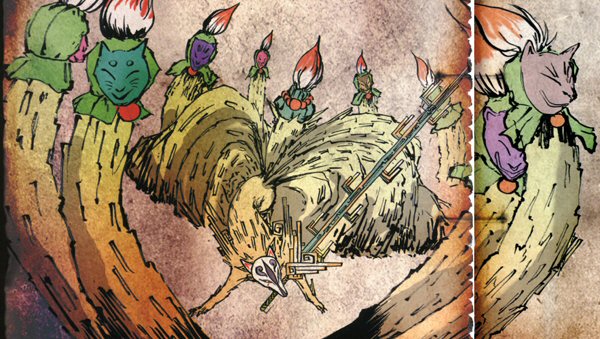
But foxes also have a habit of possessing people in Japanese folklore, as Rao so unfortunately found out in Ōkami. Typically they enter through one’s fingernails or chest (undoubtedly the latter in Rao’s case), and there’s even a Japanese phrase to describe this state of being: kitsunetsuki. There have been many hapless literary heroes over the years who have found themselves tricked or seduced by a kitsune-possessed woman or two, but the tale that concerns us most is the story of “Tamamo-no-Mae.”
Tamomo-no-Mae was an extremely beautiful courtesan who served the Japanese Emperor Konoe. She was also incredibly intelligent– even though she only appeared to be about twenty years old she could answer any question on any subject, and the Emperor (and everyone else for that matter) quickly found himself completely besotted with her. But one day he fell ill without cause or explanation and there seemed to be no cure for his ailments. Gathering his wisest advisers to solve the mystery of his illness, it was eventually discovered that Tamomo-no-Mae was really a kitsune plotting to take over the throne by getting close to the Emperor. Despite his warm feelings toward Tamomo-no-Mae, the Emperor eventually agreed to send out his best warriors to kill Tamomo-no-Mae in a bid to save himself from certain death.
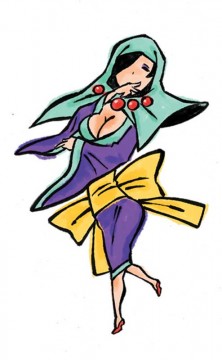 This story plays into many sub-plots of the game’s middle arc. Rao, Issun’s favourite “busty babe,” undoubtedly performs the ill-fated role of Tamomo-no-Mae, but as with the legend of Orochi and Susano, the developers have added their own twist to the tale. While Ninetails wasn’t the cause of the Emperor’s mist-spewing illness in Sei-an City (that delightful task fell to Blight), her plot to take the throne still holds true. As you might remember, the possessed Rao kills Queen Himiko in an attempt to steal her crystal ball, the only tool capable of revealing Oni Island’s ever-shifting location. But you might also remember that it is Queen Himiko herself who is first suspected of being possessed by evil. Upon seeing the devastating fog in Sei-an, Issun is disgusted by Himiko’s slow reaction to the suffering of her people and he continually accuses her of being cold and wicked for staying cooped up in her palace all day rather than trying to save her city. Ammy is also wary of her initially, growling and barking at Himiko before she reveals herself to them. Contrast this with Rao’s reception– Issun instantly succumbs to a similar infatuation as the Emperor in “Tamomo-no-Mae,” albeit perhaps more due to her rather revealing neckline than anything else, and even Ammy willingly hands over the Fox Rods to her without any sign of hesitation.
This story plays into many sub-plots of the game’s middle arc. Rao, Issun’s favourite “busty babe,” undoubtedly performs the ill-fated role of Tamomo-no-Mae, but as with the legend of Orochi and Susano, the developers have added their own twist to the tale. While Ninetails wasn’t the cause of the Emperor’s mist-spewing illness in Sei-an City (that delightful task fell to Blight), her plot to take the throne still holds true. As you might remember, the possessed Rao kills Queen Himiko in an attempt to steal her crystal ball, the only tool capable of revealing Oni Island’s ever-shifting location. But you might also remember that it is Queen Himiko herself who is first suspected of being possessed by evil. Upon seeing the devastating fog in Sei-an, Issun is disgusted by Himiko’s slow reaction to the suffering of her people and he continually accuses her of being cold and wicked for staying cooped up in her palace all day rather than trying to save her city. Ammy is also wary of her initially, growling and barking at Himiko before she reveals herself to them. Contrast this with Rao’s reception– Issun instantly succumbs to a similar infatuation as the Emperor in “Tamomo-no-Mae,” albeit perhaps more due to her rather revealing neckline than anything else, and even Ammy willingly hands over the Fox Rods to her without any sign of hesitation.
It isn’t action that prompts suspicion in Ōkami— it’s inaction, and Rao is anything but the idle priestess. Not only does she accompany Ammy through the sunken ship but she even makes her way to the Palace of the Dragonians to seek out the legendary Fox Rods as well. Yet as we duly discover, trusting those who take a more hands-on stance might actually lead to more trouble and grievance than is truly necessary, and so perhaps Ōkami reminds us that sitting still once in a while can be the right option. Equally, however, Queen Himiko’s endless prayers don’t yield particularly satisfactory results in the long run either, so maybe we need to take a more balanced approach instead.
But of course Ammy couldn’t have defeated the Dark Lord Ninetails without the help of Otohime, Queen on the Dragonians, and she too has her own place in Japanese mythology.
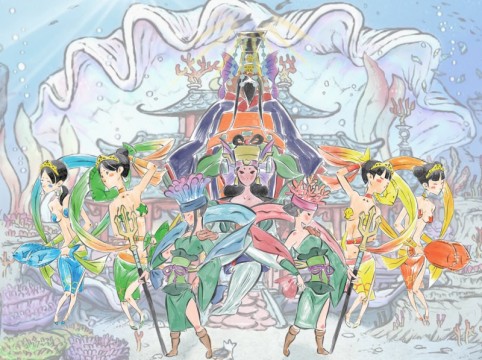
Also known as Toyotama-hime, goddess Otohime is the daughter of the sea god, Ryūjin (who her husband, King Wada, was also based off). Now those of you who know a little Japanese might have already figured out that “Ryūjin” actually translates to “Dragon God”– enter the Water Dragon terrorising Ryoshima Coast and you’ve got yourself a winning allusion. Incidentally, Ryūjin was also thought to be able to control the tides using two magical tide jewels, which fans of Ōkamiden may well recognise as Nanami’s Wet and Dry Jewels.
But before I talk a little more about Otohime, allow me to rewind just a little bit further. You might remember that Ammy only manages to gain access to the Dragon Palace through the help of Urashima, a humble fisherman who lives with his wife on North Ryoshima Coast. We first see him being beaten up by a gang of kids who denounce him as a lying toe-rag for saying he’d been to the bottom of the sea to the legendary Dragon Palace. It’s a fanciful tale to be sure, but it’s yet another story which (yep, you guessed it) rings true in the annals of Japanese literature.
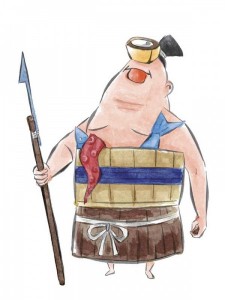 In the story of “Taro Urashima,” our fisherman hero rescues a turtle from some children who were torturing it on a beach. But the turtle turned out to be Ryūjin’s daughter, and as a reward for saving her Urashima is transported to the underwater Palace of the Dragon God to meet Ryūjin and his daughter, Otohime (now a beautiful human princess). He remains there for three days, but he soon grows homesick and longs to see his mother again. A sorrowful Otohime grants him his wish but also gives him a tamatebako (a cube-shaped box), which she warns him never to open. When he returns to the surface, Urashima finds he’s been gone a lot longer than three days– three hundred years, to be exact. Realising that his family is long gone, Urashima’s sorrow causes him to absentmindedly open Otohime’s tamatebako, and a puff of smoke suddenly transforms him into an old man. He then hears Otohime’s voice calling from the sea, and she reveals that she had hidden his old age inside the tamatebako. But due to his disobedience he can now never return to the Palace of the Dragon God.
In the story of “Taro Urashima,” our fisherman hero rescues a turtle from some children who were torturing it on a beach. But the turtle turned out to be Ryūjin’s daughter, and as a reward for saving her Urashima is transported to the underwater Palace of the Dragon God to meet Ryūjin and his daughter, Otohime (now a beautiful human princess). He remains there for three days, but he soon grows homesick and longs to see his mother again. A sorrowful Otohime grants him his wish but also gives him a tamatebako (a cube-shaped box), which she warns him never to open. When he returns to the surface, Urashima finds he’s been gone a lot longer than three days– three hundred years, to be exact. Realising that his family is long gone, Urashima’s sorrow causes him to absentmindedly open Otohime’s tamatebako, and a puff of smoke suddenly transforms him into an old man. He then hears Otohime’s voice calling from the sea, and she reveals that she had hidden his old age inside the tamatebako. But due to his disobedience he can now never return to the Palace of the Dragon God.
Interestingly, Otohime never makes any reference to Urashima when Ammy visits the Dragonians, but the tamatebako still manages to sneak its way into one of Ōkami‘s side-quests. If players return to the deathbed of the Water Dragon and bloom the patch of dead coral at its centre after they defeat Ninetails, Ammy is rewarded with the mysteriously named “treasure box” whose item description ominously reads: “Opening it will cause disaster” (the big red “Do Not Press” button of item descriptions). One of the Dragonian security guards will then jump back in astonishment at its sudden appearance and she explains that the box supposedly contains the gasps of a thousand mermaids. It’s also rumoured to grow heavier with each mermaid death and one leaked gasp is said to bring on old age in an instant. But she also dismisses the box as a legend, saying that no one really knows whether it’s true or not. But if you bring it back to Urashima, he’ll jump for joy at its discovery, revealing that he had left the treasure box behind in the Dragonian Palace when he drowned and was revived by Otohime. It’s because he went to the Dragonian Palace that he can no longer age like those around him, particularly his wife, but, sure enough, the treasure box saves the day, ridding Urashima of his eternal youth and restoring him to his rightful age when he cracks it open.
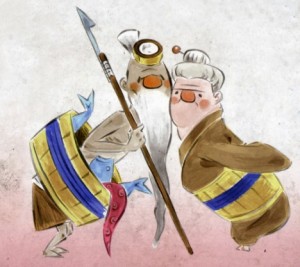 What’s particularly touching about this small scene is that when the aged Urashima embraces his wife, he declares he will never “leave” her again, and likewise his wife rejoices that her husband has “finally come back” to her, implying that despite their constant companionship they nevertheless felt estranged by their disparate ages. It also turns the old fantasy of eternal youth on its head, suggesting that once you’ve lost your own generation and become disconnected from those around you, the only future in store for you is a long and miserable one. Staying young forever isn’t all it’s cracked up to be in Ōkami, especially when your old whale pal Orca slaps you in the face with his tail in favour of taking someone else back down to the Dragonian Palace!
What’s particularly touching about this small scene is that when the aged Urashima embraces his wife, he declares he will never “leave” her again, and likewise his wife rejoices that her husband has “finally come back” to her, implying that despite their constant companionship they nevertheless felt estranged by their disparate ages. It also turns the old fantasy of eternal youth on its head, suggesting that once you’ve lost your own generation and become disconnected from those around you, the only future in store for you is a long and miserable one. Staying young forever isn’t all it’s cracked up to be in Ōkami, especially when your old whale pal Orca slaps you in the face with his tail in favour of taking someone else back down to the Dragonian Palace!
And that about wraps it up for this second instalment of hidden Ōkami mythology. Tune in next time for the third and final part of this epic saga into Japanese legends of yore where we’ll take a look at the collection of stories behind the thrilling conclusion to Ammy’s quest in the frozen north of Kamui. Until next time, readers.




 ShareThis
ShareThis






